Unit 3 How do you get to school单元复习课件(词组+句型+知识点+语法+写作指导+易错考点)
文档属性
| 名称 | Unit 3 How do you get to school单元复习课件(词组+句型+知识点+语法+写作指导+易错考点) |  | |
| 格式 | pptx | ||
| 文件大小 | 103.9MB | ||
| 资源类型 | 试卷 | ||
| 版本资源 | 人教新目标(Go for it)版 | ||
| 科目 | 英语 | ||
| 更新时间 | 2024-05-17 16:42:55 | ||
图片预览



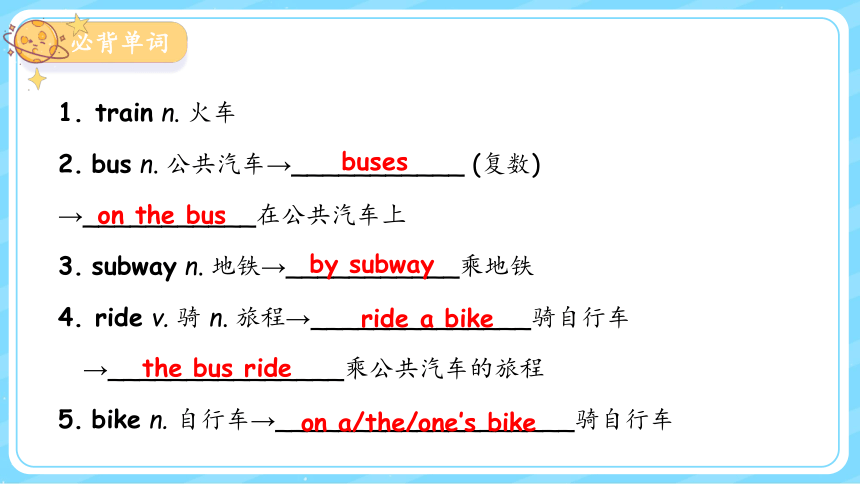
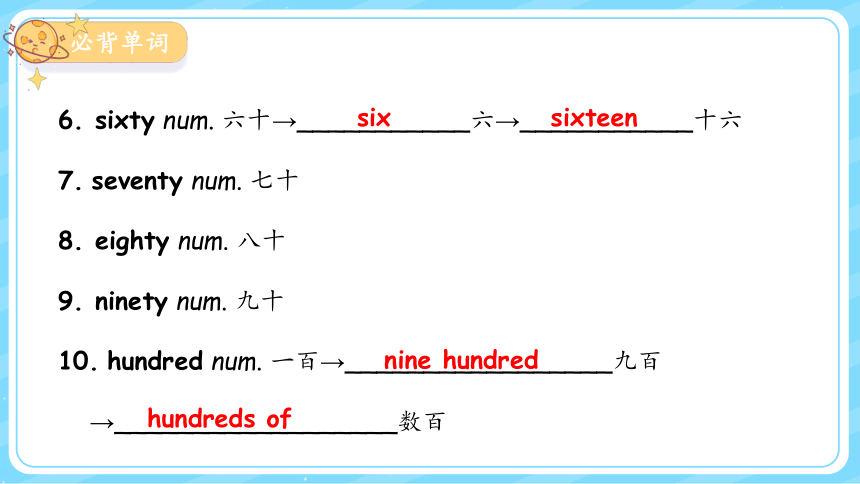
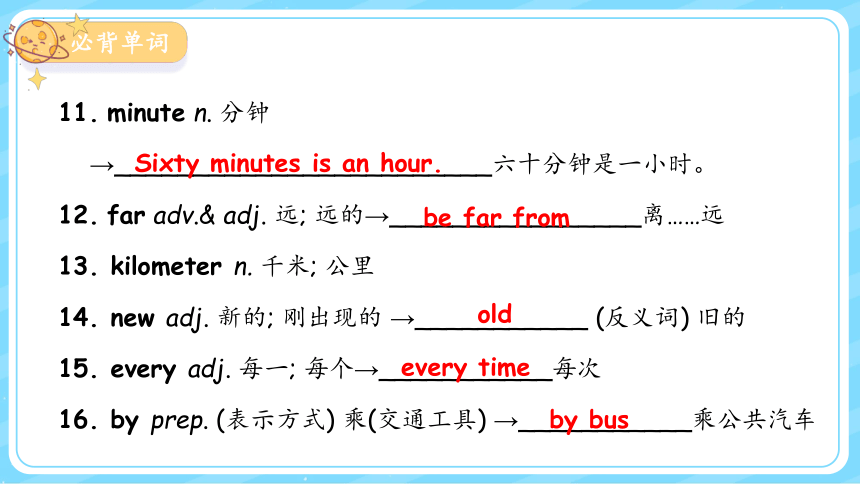
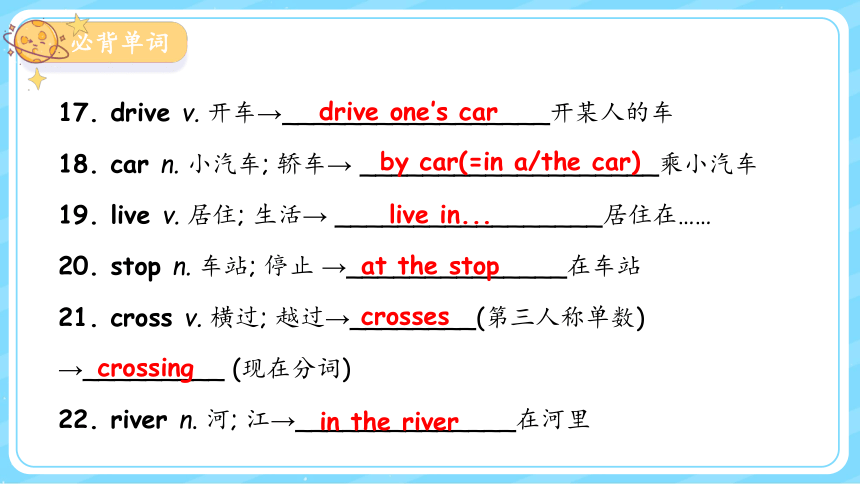
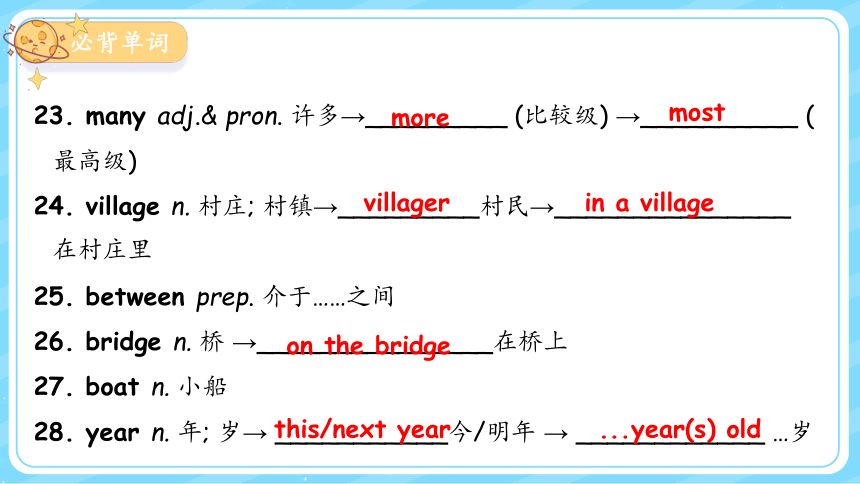
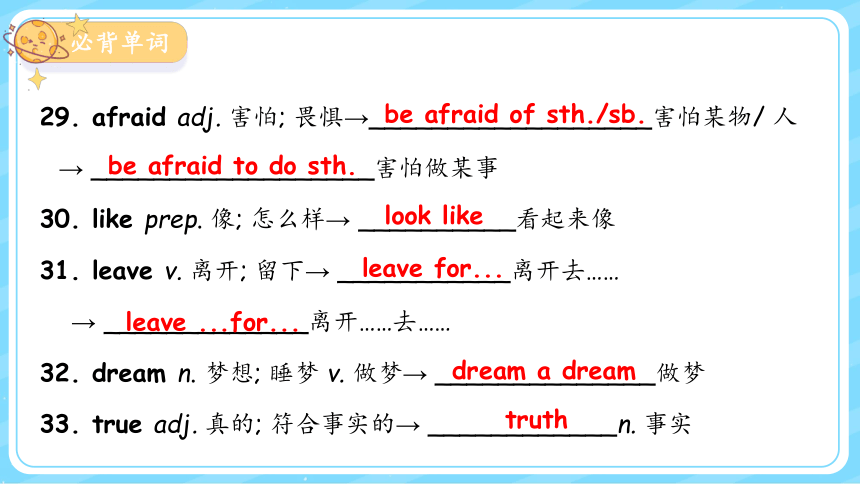
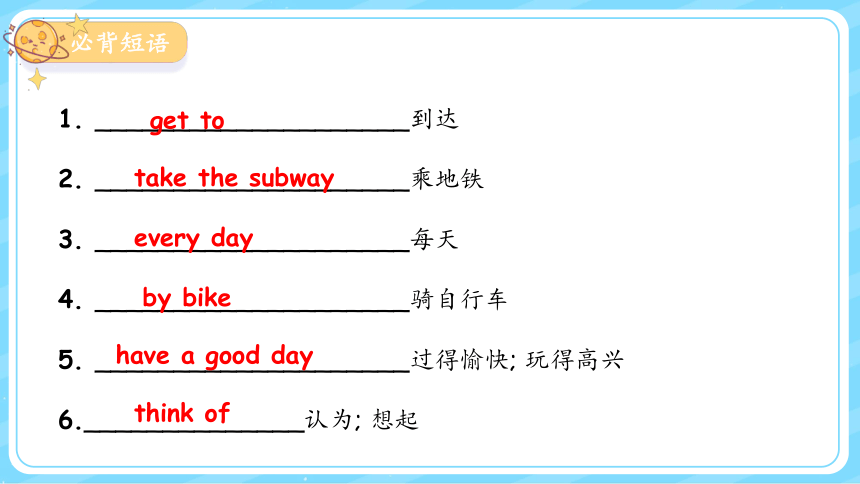
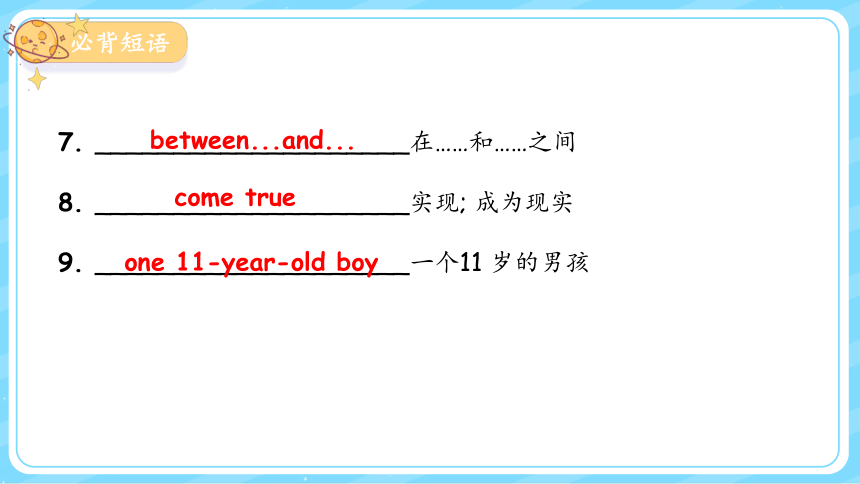

文档简介
(共148张PPT)
01
单词词组过关
03
知识点精讲
02
重点句型过关
04
单元语法专项
05
写作指导
必背单词
1. train n. 火车
2. bus n. 公共汽车→___________ (复数)
→___________在公共汽车上
3. subway n. 地铁→___________乘地铁
4. ride v. 骑 n. 旅程→______________骑自行车
→_______________乘公共汽车的旅程
5. bike n. 自行车→___________________骑自行车
buses
on the bus
by subway
on a/the/one’s bike
ride a bike
the bus ride
必背单词
6. sixty num. 六十→___________六→___________十六
7. seventy num. 七十
8. eighty num. 八十
9. ninety num. 九十
10. hundred num. 一百→_________________九百
→__________________数百
six
sixteen
nine hundred
hundreds of
必背单词
11. minute n. 分钟
→________________________六十分钟是一小时。
12. far adv.& adj. 远; 远的→________________离……远
13. kilometer n. 千米; 公里
14. new adj. 新的; 刚出现的 →___________ (反义词) 旧的
15. every adj. 每一; 每个→___________每次
16. by prep. (表示方式) 乘(交通工具) →___________乘公共汽车
Sixty minutes is an hour.
be far from
old
every time
by bus
必背单词
17. drive v. 开车→_________________开某人的车
18. car n. 小汽车; 轿车→ ___________________乘小汽车
19. live v. 居住; 生活→ _________________居住在……
20. stop n. 车站; 停止 →______________在车站
21. cross v. 横过; 越过→________(第三人称单数)
→_________ (现在分词)
22. river n. 河; 江→______________在河里
drive one’s car
by car(=in a/the car)
live in...
at the stop
crosses
crossing
in the river
必背单词
23. many adj.& pron. 许多→_________ (比较级) →__________ (最高级)
24. village n. 村庄; 村镇→_________村民→_______________ 在村庄里
25. between prep. 介于……之间
26. bridge n. 桥 →_______________在桥上
27. boat n. 小船
28. year n. 年; 岁→ ___________今/明年 → ____________ …岁
more
most
villager
in a village
on the bridge
this/next year
...year(s) old
必背单词
29. afraid adj. 害怕; 畏惧→__________________害怕某物/ 人
→ __________________害怕做某事
30. like prep. 像; 怎么样→ __________看起来像
31. leave v. 离开; 留下→ ___________离开去……
→ _____________离开……去……
32. dream n. 梦想; 睡梦 v. 做梦→ ______________做梦
33. true adj. 真的; 符合事实的→ ____________n. 事实
be afraid of sth./sb.
be afraid to do sth.
look like
leave for...
leave ...for...
dream a dream
truth
必背短语
1. ____________________到达
2. ____________________乘地铁
3. ____________________每天
4. ____________________骑自行车
5. ____________________过得愉快; 玩得高兴
6.______________认为; 想起
get to
take the subway
every day
by bike
have a good day
think of
必背短语
7. ____________________在……和……之间
8. ____________________实现; 成为现实
9. ____________________一个11 岁的男孩
between...and...
come true
one 11-year-old boy
必背句型
1. —_______ _______ _______ _______ _______ school
你是怎么到学校的?
2. _______ _______ _______ _______ _______ your home _______ school 从你家到学校有多远?
3. _______ _______ _______ _______ _______ you to get to school 到学校需要花费你多长时间呢?
How do you get to
How far is it from
to
How long does it take
必背句型
4. —________ ________ ________ get to school
她是怎么到学校的
—________ ________ takes the bus. 她通常坐公共汽车。
5. —________ Jane ________ ________ school
简步行去上学吗?
—________, ________ ________. She goes by bike.
不, 她不是。她骑自行车去。
How does she
She usually
Does walk to
No she doesn’t
必背句型
6. For many students, _________ _________ _________ _________ _________ to school.
对许多学生来说, 到达学校是很容易的。
7. _________ _________ no bridge and the river _________ _________ quickly _________ boats.
(河上) 没有桥, 而且水流湍急, 不宜小船摆渡。
8._________ _________ your last e-mail.
谢谢你的上一封电子邮件。
it is easy
to get
There is runs
too for
Thanks for
more pretty ppt platmate is from——https:///
Part 3
重点句型过关
知识点1:take the train
考向:take the train 乘车
“take + the/a + 交通工具” 的结构,用来表示乘坐某种交通工具,意为“乘……;坐……”,相当于“go to...by+ 交通工具”。其中take 作动词,意为“乘(车、飞机、轮船等)”。
e.g. They take a train to the mountains.
他们乘火车去了山区。
拓展:take 的用法还有:
take v. 拿走;带走
e. g. Please take the books to the school library.
请把这些书带到学校图书馆。
v. 买下
e. g. I’ll take these clothes. They look so nice.
我要买下这些衣服,它们看起来这么漂亮。
v. 花费
e. g. It takes me 20 minutes to get to the park.
我花费了20 分钟到公园。
类似的表达还有:
① take the/a bus 乘公共汽车
② take the/a car 乘小汽车
③ take the/a plane 乘飞机
④ take the/a subway 乘地铁
⑤ take the/a taxi 乘出租车
典型例题
1.—Does your teacher go to work by _______ car every day
—No. He usually takes _______ bus.
A. /; / B. /; the C. a; the D. the; a
2.Kate takes a bus to school every day.(改为同义句)
Kate goes to school _______ _______ every day.
by bus
知识点2:bus /b s/ n. 公共汽车
take the/a bus=by bus 意为“乘公共汽车”。
bus 的复数形式为buses。
e.g. My brother usually takes the/a bus to work.
= My brother usually goes to work by bus.
我哥哥通常乘公共汽车去上班。
There are lots of buses in the city. 城市里有许多公共汽车。
by 和bus 之间没有冠词或其他限定词,且bus 不用复数。
辨析: take the/a bus与on the /a bus
take the/a bus 乘坐公共汽车(动作) He often takes the/a bus to work.
他经常乘坐公共汽车去上班。
on the/a bus 在公共汽车上 They are talking on the bus.
他们正在公共汽车上交谈。
易错点:与bus用法相同的单词有train,subway,car 等,但car 之前的介词用in。
知识点3:ride /ra d/ v. 骑
e.g. He has to ride more than 70 kilometers.
他不得不骑行70 多公里。
Jack always rides a bike to school.
=Jack always goes to school by bike.
杰克总是骑自行车去上学。
Can you ride a horse 你会骑马吗?
作不及物动词
作及物动词
知识点3:ride /ra d/ v. 骑
拓展:ride 作名词时,意为“旅程”,尤其指乘车、骑车的短途旅程。
e.g. Jack sat alone on the bus ride home from school.
杰克独自坐在放学回家的公交车上。
用法:“ride (a/the/one’s bike) to + 地点名词” = “go to+ 地点名词+by bike”,表示“骑自行车去某地”。
知识点3:ride /ra d/ v. 骑
ride 的常见用法:
① ride a/the/one’s bike 骑自行车
② ride a/the horse 骑马
知识点4:How 引导的特殊疑问句,询问交通方式
考向:“How do/does sb. get to... ” 意为“某人如何到达…… ”, 这是用来询问交通方式的交际用语。其答语主要有以下几种:
(1) Sb. take(s)/drive(s)/ride(s) + a/the/one’s+ 交通工具.
(2) Sb. get(s) to ... by + 交通工具./By + 交通工具./On foot.
(3) Sb. get(s) to... on/in + a/the/one’s + 交通工具.
当表示“步行”时,要用Sb. walk(s).
知识点4:How 引导的特殊疑问句,询问交通方式
e.g. —How do you come to the club 你怎么来俱乐部的?
—By bus./I take the bus. / On a bus. (我) 乘公共汽车。
交通方式的表达:
by+ 交通工具
take a/the+ 交通工具
drive+ 冠词/形容词性物主代词+ 交通工具
ride+ 冠词/形容词性物主代词+ 交通工具
典型例题
—______ did you get to Zigong yesterday
—By high-speed train.
A. Where B. How C. When
【点拨】由答语“ 乘高铁。” 可知, 对方想知道“怎么到达自贡”,用how。
典型例题
—How are you going to Shanghai, Harry
—_______ plane.
A. Of B. In C. By
知识点5:get to 到达
考向:后接地点名词,表示“到达某地”;当表示目的地的词是副词home,here,there 等时,要去掉to。
e.g. We will get to school at 7:50. 我们将在7:50 到达学校。
We’ll get there on foot. 我们将步行到那里。
典型例题:It is raining hard. I am afraid that we can’t ________ (到达) the airport on time.
get to
知识点6:hundred /h ndr d/ num. 一百
辨析: hundred与hundreds of
hundred 前面有具体数字时, 用“基数词+hundred”表示“几百”。
hundreds of “数百”, 表示概数, 此时不能与数词连用, 但可以与many, several 等连用。
知识点6:hundred /h ndr d/ num. 一百
e.g. There are eight hundred students in our school.
在我们学校有八百个学生。
We quickly fill our bags with hundreds of tiny trees.
我们很快把袋子装满数百棵小树。
拓展:与hundred 有类似用法的单词还有thousand, million,
billion 等。
知识点6:hundred /h ndr d/ num. 一百
易错点:
hundred, thousand,million, billion 的用法:前有具体数字无s 无of;
表示模糊概念有s 有of。
知识点6:hundred /h ndr d/ num. 一百
易错点:
用英语表示“几百几十几”时,应在百位数和十位数或个位数之间加and。
356 three hundred and fifty-six
208 two hundred and eight
典型例题
Dongjiang Lake is a good place to have fun and _______
tourists go camping there in summer.
A. hundred B. hundreds C. hundreds of
【点拨】用“基数词+ hundred”表示“几百”,用“hundreds + of ”表示概数,故此处用hundreds of。
知识点7:every day 每天
考向:常与一般现在时连用。其中every 作形容词,指数目不确定的许多人或物中的“每一个”,后接可数名词单数。
与every day 类似的短语还有:
every week 每周 every month 每月
every term 每学期 every year 每年
知识点7:every day 每天
e.g. He exercises every day. 他每天都锻炼。
He knows every student in our class.
他认识我们班上的每一个学生。
Every student gets to school on time.
每个学生都按时到校。
“every+可数名词单数” 作主语时,谓语动词用单数形式。
知识点7:every day 每天
辨析:every day 与everyday
every day 副词性短语, 在句中作时间状语, 常用于一般现在时中。
everyday 作形容词, 意为“每天的; 日常的”, 可作定语修饰名词。
知识点8:how far 多远
e.g. —How far is it from the bookstore to the supermarket
(How far is the supermarket from the bookstore )
从书店到超市多远?
—About 2 kilometers. 大约2 千米。
考向:How far is it from...to... = How far is...from...
意为“ 从…… 到……多远?”用来询问距离或路程的远近。
far /fɑ (r)/ adv. & adj. 远;远的
far 作副词,意为“远”,常与from 和away 连用。
e.g. Jack doesn’t live far from here.
杰克住得离这里不远。
作形容词,意为“远的;遥远的”。
e.g. My uncle is going to a far country.
我的叔叔将要去一个遥远的国家。
温馨提示: far 的反义词为near,意为“近的”。
知识点9:I’m not sure. 我不确定。
考向:交际用语,是表达自己对某事没有十足把握的固定用语。
e.g. —How about John 约翰呢?
—I think he will go with us, but I’m not sure.
我认为他会跟我们一起去,但我不确定。
知识点9:I’m not sure. 我不确定。
拓展:sure 为形容词,意为“肯定,确信;一定,必定”。
e.g. I’m sure of his words. 我对他的话深信不疑。
And we should be sure to eat foods that are rich in vitamin D,
too. 我们也应该确保吃富含维生素D 的食物。
I’m sure that we’ll get there on time.
我确信我们会准时到达那儿。
知识点9:I’m not sure. 我不确定。
sure 的常见用法:
① be sure of sth. 对某事有把握;确信……
② be sure to do sth. 务必做某事
③ be sure+that 从句 确信……
典型例题
—Will you join us for the party tomorrow
—_______ Maybe I’ll have a meeting.
A. That’ll be great! B. I’m not sure. C. Certainly.
【点拨】用情景交际法。That’ll be great 那太好了;I’m not sure 我不确定;Certainly 当然了。由答语中“Maybe ...”可知说话人不确定是否要参加。
知识点10:How long 多长时间
考向:用来询问时间的长短,其谓语动词应是延续性动词,答语常用表示一段时间的名词性短语。
e.g. —How long does he live in the village
他在这个村子住了多长时间?
—About a year. 大约一年。
知识点11:It takes (sb.) some time to do sth.
It takes (sb.) some time to do sth.
做某事花费(某人) 一些时间。
e.g. It usually takes him two hours to get home from work.
通常下班后回家要花费他两个小时的时间。
take在此处意为“花费”
此句型中It 为形式主语,真正的主语是后面的动词不定式“to do sth.”。
典型例题
—How do you usually go to Wuhan from here
—By high-speed train. It _______ me only 20 minutes to get there.
A. spends B. pays C. costs D. takes
【点拨】用固定句式法。“It takes sb. some time to do
sth.”意为“做某事花费某人多长时间”,是固定句型。
知识点12:关于询问交通方式的一般疑问句及其回答
—Does Jane walk to school
—No, she doesn’t. She goes by bike.
考向:本句主语是第三人称单数,用助动词does 来构成一般疑问句及其否定回答。当主语不是第三人称单数时,要用助动词do来构成一般疑问句及其否定回答。
肯定答语:Yes,主语+ does/do.
否定答语:No,主语+ doesn’t/don’t.
知识点12:关于询问交通方式的一般疑问句及其回答
e.g. —Do they take the bus to school
他们乘公共汽车去上学吗?
—No,they don’t. They walk.
不,他们不是。他们步行。
知识点13:walk to... 步行去……
e.g. All the students walk to school every day.
= All the students go to school on foot every day.
所有的学生每天步行去上学。
The town is about 10 km away and we always walk there —it’s great exercise!
那个镇在大约10 公里外,我们总是走到那里——那是很棒的锻炼!
相当于go to...on foot
walk to 后接表示地点的词:
①当表示地点的词是名词时,用walk to...;
②当表示地点的词是here, there, home 等副词时,要省略to。
知识点13:walk to... 步行去……
知识点14:live /l v/ v. 居住; 生活
考向:live 意为“居住”,用作不及物动词,后面不能直接跟地点名词,若跟地点名词需要加适当的介词;若接副词,则不用加介词。
e.g. Where do you live
你住在哪里?
My uncle lives in Beijing.
我叔叔住在北京。
live 后加介词再加地点名词。
知识点14:live /l v/ v. 居住; 生活
拓展:表示居住地与某地之间的距离:
Sb. live(s) + 路程+from + 地点.
e.g. I live ten kilometers from the supermarket.
我住得离超市十公里远。
知识点14:live /l v/ v. 居住; 生活
live 用作动词时的其他含义:
① 生存,活着
We can’t live without water.
我们没有水就不能生存。
②(以某种方式)生活,过日子
She lived a very peaceful life.
她过着十分宁静的生活。
知识点15:stop /st p/ n. 车站;停止
stop 用作名词时的常见词组:at the bus stop 在公共汽车站;
come to a stop 停下来。
辨析: stop 与station
stop “车站”,一般指公共汽车在路上停留、乘客上下车的小站点。
station “车站”,规模较大的车站,一般指始发站和终点站。
知识点15:stop /st p/ n. 车站;停止
e.g. The bus stop is not far from my home. 公共汽车停靠站离我家不远。
Many buses leave that big bus station.
许多公共汽车离开了那个大公共汽车站。
stop 用作动词时的常见用法:
① stop to do sth. 停下来去做某事
② stop doing sth. 停止做某事
③ stop sb. from doing sth. 阻止某人做某事
知识点15:stop /st p/ n. 车站;停止
拓展:stop 既可作名词,也可作动词,意为“停止”。
e.g. The car comes to a stop. 汽车停了下来。
Let’s stop to have a rest.
咱们停下来(原来干的事),(去)休息一下吧。
Stop talking, please. 请停止(正在)说话(这个动作)。
His mother stops him from watching TV.
他妈妈阻止他看电视。
n.停止
v.停止
典型例题
—Tom, it’s time to go to bed. Stop ______ TV.
—OK, Mum.
A. watch B. watching C. to watch D. watches
【点拨】stop to do sth. 意为“停下来去做某事”,stop doing sth. 意为“停止做某事”。根据“it’s time to go to bed”可知,是指停止看电视。
知识点16:宾语从句的语序
Mary wants to know where Bob lives.
在含有宾语从句的主从复合句中,无论是陈述句还是疑问句,宾语从句都必须使用陈述句语序,疑问词位置不变。
e.g. He doesn’t know what his father’s favourite music is.
他不知道他父亲最喜欢的音乐是什么。
Do you know what Mr. Smith’s phone number is
你知道史密斯先生的电话号码是多少吗?
宾语从句,作know 的宾语,是陈述句语序。
典型例题
—Jenny, do you know ________
—She is from Canada.
A. where is the woman in red from
B. where the woman in red is from
C. what the woman in red likes
【点拨】分析句子结构可知,此处是宾语从句,从句用陈述句语序,排除A 选项。结合答语“She is from Canada.”可知,询问来自哪里,用where询问。
知识点17:think of 认为;想起
考向:“What do you think of... ”意为“你认为……怎么样?”,相当于“How do you like... ?”,用来询问对某事、某物或某人的看法。回答时要说出具体的看法或意见。
e.g. —What do you think of the movie
= How do you like the movie 你觉得这部电影怎么样?
—It’s great. I love it. 太棒了。我喜欢。
think of 为固定短语,后可接名词、代词或动词的-ing 形式作宾语。
知识点17:think of 认为;想起
拓展:think of 意为“想起”,与remember 同义。
e.g. This old picture lets him think of his good friend.
这张旧照片让他想起了他的好朋友。
We must think of/about the cost.
我们必须考虑成本。
think 的相关短语:
think highly of 高度评价;器重
think up 想出;发明
think back 回忆;回想
think out 仔细思考,全面考虑
think over 仔细思考,认真考虑
典型例题
—________
—It’s very interesting.
A. What do you think of the book
B. Do you like the interesting book
C. Let’s go to watch a book.
D. How can you go to the book
典型例题
—What’s up, Lisa
—I have to hand in the report tomorrow, but I can’t _______ anything to write.
A. talk of B. think of C. speak of D. hear of
【点拨】用语境判定法。由答语前半句“明天我必须交报告”可知,后面表示“但是我还没想起写什么”。Think of 意为“想起”。
知识点18:cross /kr s/, /kr s / v. 横过;越过
辨析:cross,across 和crossing
cross 动词,意为“横过;越过”。 cross=go across
across 介词或副词,意为“横过” crossing 名词,意为“十字路口”。 知识点18:cross /kr s/, /kr s / v. 横过;越过
e.g. Please be careful when you cross the road.
当你过马路时请小心。
Go across/Cross the street and you can find it.
穿过这条街道你就能找到它。
Turn left at the second crossing.
在第二个十字路口向左拐。
知识点18:cross /kr s/, /kr s / v. 横过;越过
拓展:
(1) cross 还可作名词,意为“十字形记号;叉字形记号”。
e.g. Put a cross on the map to show where our school is.
在地图上画个十字,标出我们学校的位置。
(2) 作形容词,意为“生气的”。
e.g. The teacher is cross because Li Ming is late for class.
老师很生气因为李明上课迟到了。
知识点19:It is + adj. + to do sth. 做某事是……的
For many students, it is easy to get to school.
对……来说;对……而言
考向:It is + adj. + to do sth. 做某事是……的
It 为形式主语,后面的动词不定式“to do sth.”是句子的真正主语。本句为了强调,把“For many students”放到了句首。正常的语序应是“It is easy for many students to get to school.”。
知识点19:It is + adj. + to do sth. 做某事是……的
温馨提示:英语中,当动词不定式短语或动名词(短语)作主语时,谓语动词通常用单三形式;且此时常用it作形式主语,将动词不定式放在后面。
It is + adj. + for sb. + to do sth. for 后跟对象,意为“就……而言;对……
来说”,句中的形容词是描述事物特征的。
It is + adj. + of sb. + to do sth. 意为“某人做某事是……的”。形容词是表示人的特点、性格或特征的。
e.g. It is difficult for me to speak French.
对我来说,说法语是困难的。
It is nice of you to help me. 帮助我你真是太好了。
典型例题
It’s important for us _____ hard in order to have a better life.
A. work B. to work C. working
—It is convenient _____ us _____ things online.
—So it is.
A. for; to buy B. of; to buy C. for; buy
知识点20:many/meni/ det. & pron. 许多
辨析:many, much 与lots of
many 修饰 可数名词复数 There are many trees in the park.
公园里有许多树。
much 修饰 不可数名词 It takes him much time to get there.
他花费了很多时间到达那里。
lots of = a lot of 既可修饰可数名词复数,又可修饰不可数名词 You can see lots of trees/water over there. 在那边你能看到许多树/ 水。
知识点21:there be 句型
考向:“There be + 某人 / 某物+ 某地 / 某时.”,意为“某地或某时有某人或某物”。
e.g. There are four men and a woman using computers.
有四位男士和一位女士正在使用电脑。
There is an apple and two pears on the table.
桌子上有一个苹果和两个梨。
易错点:
当有两个或两个以上并列主语时,there be句型遵循“就近原则”,即be动词取决于离它最近的名词的单复数。
典型例题
1.—There _______ a lot of new magazines in our school reading room.
—Oh, really Shall we go there this afternoon
A. is B. was C. are D. were
2.There ________ some milk and several apples in the fridge.
A. is B. are C. be
知识点22:between /b 'twi n/ prep. 介于……之间
辨析:between 与 among
between 一般用于两者之间,其宾语往往是表示两者的名词或代词,或是由and 连接的两个人或事物。
among 表示三者或三者以上的人或物之间,宾语可以是复数名词或代词,也可以是集合名词。
知识点22:between /b 'twi n/ prep. 介于……之间
e.g. This village lies between two mountains.
这个村庄位于两座山之间。
That village lies among the mountains.
那个村庄位于群山之中。
There is a road between this village and that one.
在这个村庄和那个村庄之间有一条路。
between...and... 意为
“在……和……之间”。
易错点:
表示“三个或三个以上的人或物中的每两个之间”用between。
典型例题
约翰尽力在工作和娱乐中获得平衡。
John does his best to keep the balance _________ work _________ play.
between
and
知识点23:11-year-old 11 岁的
11-year-old 11 岁的
考向:是由“基数词+连字符+ 可数名词单数形式+连字符+ 形容词”构成的复合形容词,常用来作定语。
e.g. This is an 8-month-old baby. 这是一个八个月大的婴儿。
It’s a 300-meter-long bridge. 它是一座长300 米的桥。
知识点23:11-year-old 11 岁的
辨析: 11-year-old 与11 years old
11-year-old 用连字符连接,中间的名词用单数,在句中作定语。
11 years old 不用连字符连接,中间的名词用复数,在句中作表语。
两者可以互换使用。
易错点:
由“基数词+ 单数名词+形容词”构成的复合形容词的特点:
① 三个词之间要有连字符;
② 中间的名词必须是单数;
③ 只能作定语,不可作表语。
知识点23:11-year-old 11 岁的
e.g. He is an 11-year-old boy. 他是一个11 岁大的男孩。
= The boy is 11 years old. 这个男孩11 岁了。
拓展:此类复合形容词的结构中,形容词还可以是long 长的/wide 宽的/high 高的/tall 高的/deep 深的/thick 厚的……
e.g. a three-meter-long snake 一条3 米长的蛇
典型例题
—The _______ girl has won the prize of International Master of Memory.
—Wow, she’s great, isn’t she
A. ten-year-old B. ten-years-old
C. ten year old D. ten years old
知识点24:afraid / 'fre d/ adj. 害怕;畏惧
afraid / 'fre d/ adj. 害怕;畏惧
e.g. Why are you so afraid 你为什么这么害怕?
Cathy is afraid of the dog. 凯西怕狗。
I’m afraid (that) you’ll miss your favorite subject.
恐怕你将错过你最喜欢的学科。
拓展:I’m afraid so /not. 意为“恐怕是这样/ 恐怕不是这样”。
知识点24:afraid / 'fre d/ adj. 害怕;畏惧
辨析: be afraid to do sth.与 be afraid of (doing) sth.
be afraid to do sth. 表示“害怕做某事”,即主语对做某事感到恐惧。 He was afraid to go out alone at night.
他害怕晚上独自外出。
be afraid of (doing) sth 表示主语内心不情愿做某事, 担心某事可能发生。 She was afraid of waking her husband up.
她怕吵醒她丈夫。
知识点24:afraid / 'fre d/ adj. 害怕;畏惧
— Rose isn’t here today. Is she ill
罗丝今天不在这里。她生病了吗?
— I am afraid so. I saw her at the doctor’s this morning.
恐怕是这样。今天早上我在诊所看到过她。
afraid 的常见用法:
① be afraid of sb./sth. 害怕某人/某物
② be afraid to do sth.
害怕/ 不敢做某事
③ be afraid of doing sth. 害怕做某事
④ be afraid + (that) 从句 害怕……
知识点25:like /la k/ prep. 像;怎么样
辨析: be like 与look like
be like “像”,多指性格、品质方面像,也可指外貌上像。
look like “看起来像”,指外观或外貌上像。
知识点25:like /la k/ prep. 像;怎么样
e.g. The girl is like her sister. They’re both outgoing.
这个女孩像她姐姐。她们都很外向。
The cloud looks like a horse. 这朵云看上去像一匹马。
拓展:like 用作动词,意为“喜欢”。
常用搭配:like sth. 喜欢某物;
like doing/to do sth. 喜欢做某事
e.g. We like to play the guitar. 我们喜欢弹吉他。
Jack likes riding a bike to school. 杰克喜欢骑自行车去学校。
like 的相关句型:
① What’s sb. like
某人怎么样? (侧重于询问性格、品质)
② What does sb. Look like
某人长得怎么样?(侧重于询问外表)
知识点26:leave /li v/ v. 离开
e.g. Let’s leave at 6:00.
让我们6 点离开吧。
He leaves home early every day.
每天他早早地离开家。
不及物动词
及物动词
辨析: leave, leave for 与leave A for B
leave 后跟的地点为“出发地” When do you leave school
你什么时候离校?
leave for 后跟的地点为“目的地” ,意为“动身前往某地”。 He will leave for Shanghai tomorrow.
明天他将动身去上海。
leave A for B A 为“出发地”B 为“目的地” ,意为“离开A地前往B 地”。 He wants to leave Beijing for Shanghai.
他想离开北京去上海。
知识点26:leave /li v/ v. 离开
拓展:leave 还可意为“留下;丢下;剩余”等。
e.g. I left my schoolbag at home.
我把我的书包落在家了。
Hurry up! There’s little time left.
快点!几乎没有时间了。
典型例题
Remember(记得) to turn off the lights when you __________ (离
开) the classroom.
leave
【点拨】主句“Remember(记得) to turn off the lights”是祈使句,所以从句是一般现在时,主语是you,谓语动词用原形。
知识点27:dream /dri m/ n. 梦想;睡梦 v. 做梦
可数名词,意为 “梦想;睡梦” He has dreams every night.
他每天晚上都做梦。
His dream is to be an astronaut.
他的梦想是成为一名宇航员。
动词,意为 “做梦” She often dreams at night.
她晚上经常做梦。
知识点27:dream /dri m/ n. 梦想;睡梦 v. 做梦
拓展:dream of /about“梦想;梦见”,后接动词时,要用动词的 ing 形式,或者后面直接接名词。
e.g. Many people dream of becoming famous.
很多人梦想成名。
I dreamt about a plane last night.
昨天晚上我梦见了一架飞机。
知识点28:come true 实现
考向:come true 是不及物动词短语,主语常是梦想(dream) 、希望(wish) 或目标等,其后不能跟宾语。make... come true 意为“使……实现”。
e.g. Happiness is about having each tiny wish come true.
幸福是每一个微小愿望的实现。
How can you make your dream come true
你怎样让你的梦想实现?
come in 进来
come out
出版;开花
come over 过来;拜访
come on 加油
come back 回来
come from 来自……
与come相
关的短语
知识点29:true /tru / adj. 真的;符合事实的
e.g. I think you are a true friend.
我觉得你是一个真正的朋友。
Tom can tell us the truth. 汤姆可以告诉我们真相。
He truly loves his children. 他由衷地爱他的孩子们。
true 的词形变化:truth n. 真相;事实
truly adv. 真正,确实
how 引导的特殊疑问句
how “怎样; 如何” 概述 how 是疑问副词, 意为“如何,怎样”, 常位于句首, 引导特殊疑问句。
句式结构 How + 助动词/ 情态动词+ 主语+ 实义动词原形(+ 其他)?
How + be 动词+ 主语+(其他)?
常见用法 询问方式或方法
询问健康情况或对某事的看法
询问天气状况及事情进展情况
how 引导的特殊疑问句
与how 有关的 疑问 短语 how long:用于提问时间长短,意为“多长时间”; 用于询问物体的长度,意为“多长”。
how far:用于提问距离,意为“多远”。
how often:用于询问做某事的频率, 意为“多久一次”。
how soon:意为“多久以后”, 常用于一般将来时。
how about...:意为“……怎么样”, 相当于“what about...”。
考点1:how 询问方式或方法
e.g. —How do you go home every day 你每天怎么回家?
—I drive my car home.=I go home by car.
=I go home in my car. 我开车回家。
典型例题: —_______ do you usually go to school, Mary
—By bike.
A. When B. How C. Where D. Why
考点2:询问健康情况或对某事的看法
e.g. —How is your grandfather 你爷爷怎么样?
—He is fine. 他很好。
I think the music is great. How do you like it
我觉得这个音乐很棒。你觉得它怎么样?
典型例题:—Hey, Jane. ______ are you feeling now
—Much better. Thanks.
A. What B. Where C. How D. When
考点3:询问天气状况及事情进展情况
e.g. It’s rainy here. How’s it in your city
这儿是雨天。你所在的城市天气怎么样
— How’s it going 事情进展如何?
— Not bad. 还不错。
考点4:how long 的用法
e.g.
How long does it take you to finish your homework
完成家庭作业花费你多长时间?
How long is the river
这条河有多长?
问时间长短
问长度
典型例题
—_______ have you been a member of the Helpers’ Club
—For two years.
A. How soon B. How long C. How often
【点拨】用语法分析法。How soon“多久以后”,对将来的时间进行提问,回答时一般用In 加上时间段;How long“多长时间”,对一段时间提问;How often“多久一次”,对频率提问。由答语“两年。”可知是对一段时间提问。
考点5:how far 的用法
how far 提问距离的答语分为两种情况:
(1) 用长度单位表示
e.g. —How far is it from your home to the bus stop
从你家到公共汽车停靠站有多远?
—It’s two kilometers. 两公里远。
考点5:how far 的用法
(2) 用时间表示
e.g. —How far is the park from the supermarket
公园离超市有多远?
—It’s 5 minutes’ walk. (= It’s 5 minutes on foot.)
步行5 分钟的路程。
典型例题
—________ is the China Tiangong space station from us
— About 400 kilometers above the earth.
A. How much B. How often
C. How far D. How long
【点拨】由答语“距离地球约400 公里。”可知上句是询问距离。How far意为“多远”,用于对距离进行提问。
考点6:how often 的用法
how often:用于询问做某事的频率, 意为“多久一次”。
e.g. How often does Lucy visit her aunt
露西多久看望一次她的姑妈?
典型例题: —_______ do you go swimming, Sam
—Every Sunday afternoon.
A. How often B. How soon C. How long
考点7:how soon 的用法
how soon:意为“多久以后”, 常用于一般将来时。
e.g. —How soon will she be back
她多久以后会回来?
—She will be back in 3 months.
3 个月以后她将会回来。
典型例题
— Lingling, how soon will your brother come back from abroad
—Hmm, _______.
A. since yesterday B. twice a month
C. for an hour D. in a week
【点拨】根据语境可知,Lingling 的弟弟一周之后会从国外回来。对how soon提问的句子的回答要用“in+ 一段时间”。
考点8:how often 的用法
how about...:意为“……怎么样”, 相当于“what about...”。
e.g. How about going to the beaches for a vacation
去海滩度假怎么样?
典型例题: —Li Lin, _______ playing football this Sunday
—That sounds like a good idea.
A. why not B. how about
C. what D. where
韩诚是你的朋友,他在一所中学上学。他家离学校约2 公里,他通常骑自行车上学,大约用时15 分钟。下雨的时候他爸爸开车送他。他的父母在离家10 公里的一家工厂上班,他们每天开车上班,大约需要20 分钟。他觉得骑自行车……
请根据提示写一篇不少于80 词的短文。
单元话题
1. 写作时应用一般现在时,要用第三人称,且要包括以上所有信息。
2. 表达交通方式、距离、花费时间的句型要恰当、合理。如:“by + 交通工具”、“take/drive/ride the + 交通工具”、“It takes + sb. + 时间+ to do sth.”等。
审题指导
写作方法
第一步:点名目的地;
第二步:详细介绍交通方式;
第三步:总结全文.
三步法写如何
到达目的地
写作模板
『三步法』写如何到达目的地 开篇点题 Han Cheng... studies in a... 具体描述 平时 上学 His home is... He usually rides a bike... and it takes ...
雨天 上学 But when it rains, ... in his father’s car.
父母 上班 His father and mother... It’s... It takes...
总结全文 Han Cheng likes... because he thinks it’s... and it’s...
经典词句
单词 at, usually, often, always, never, sometimes, exercise
短语 get up, go to school, get dressed, brush teeth, eat breakfast, take a shower, take a walk, do one’s homework, go to work, go to bed, do sports, from... to...
句子 ① He usually rides a bike to school and it takes him about fifteen minutes to get to school.
② It’s ten kilometers from their home.
③ It’s good exercise and it’s good for the environment.
范文赏析
Han Cheng is my friend. He studies in a middle school.
His home is about two kilometers from his school. He usually rides a bike to school and it takes him about fifteen minutes to get to school.① But when it rains, he goes to school in his father’s car.② His father and mother both work in a factory. It’s ten kilometers from their home. They drive a car to work every day. It takes them about twenty minutes to get there.
范文赏析
Han Cheng likes going to school by bike because he thinks it’s good exercise and it’s good for the environment.③
名师点评
本文运用“三步法”写如何到达目的地。
1. 点明目的地:school,factory;
2. 交通方式:rides a bike, in his father’s car,drive a car;
3. 表明韩诚对于自己到校方式的看法:good exercise, good for the environment。
名师点评
添彩点:
①灵活运用句型“It takes sb. + 时间+to do sth.”来介绍到目的地所花费的时间;
② when 引导的时间状语从句的使用丰富了表达方式;
③用because 引导的原因状语从句表明自己喜欢骑自行车去上学的原因,增强了短文的逻辑性。
写作任务
假设刘蕙是你的好朋友。请你根据表格中的信息,写一篇60词左右的短文介绍一下她去上学的不同方式。
Who How far How How long
Liu Hui 大约3公里 骑自行车; 乘公共汽车; 步行 15分钟
20分钟
40分钟
思路点拨
介绍刘蕙
上学的情况
not far from,3 kilometers
leave home,ride her bike, take,15 minutes, by bus, 20 minutes, wait for(等候),walk, 40 minutes
enjoy
范文赏析
Liu Hui is my good friend. She goes to school in different ways.
Liu Hui doesn’t live far from school. It’s about 3 kilometers from her home to school. She usually leaves her home at 7:20 a.m. She usually rides her bike to school, and it takes her 15 minutes. Sometimes she goes to school by bus and the bus ride takes her 20 minutes, because too many people wait for the bus. Sometimes she walks to school with her friends and it takes 40 minutes, but she thinks walking is like exercise, and that it’s good for health.
写作实践
请你根据下表提示内容,介绍一下Tim与 Lily上学的方式,同时也介绍一下自己选择的上学交通方式,并说说理由。
姓名 Tim Lily 我
离学校距离 远 近 ……
交通方式 公共汽车 步行 ……
花费时间 半小时 10分钟 ……
观点 快,有趣 健康,便宜 ……
范文赏析
Tim and Lily are my good friends. We go to the same school and we are in the same class. Tim lives far from school. So he goes to school by bus. It takes him half an hour to get to school. He thinks it’s fast and interesting to go to school by bus. Lily lives near our school. So she walks to school. It takes her 10 minutes. She thinks walking to school is healthy and cheap. How about me? It is five kilometers from my home to school. I usually ride my bike to school. It takes me 15 minutes to get to school by bike. I think it’s a good way to exercise.
易错考点1:交通方式的表达
交通方式的表达:
1. by+交通工具(单数);
2. take a/the+交通工具;
3.某些动词短语,如ride one’s bike;
4. by+水、陆、空等 。
易错考点1:交通方式的表达
用适当的介词填空。
1. Linda’s home is far from our school. So she usually goes to school by bus.
2. Wendy came to school in her father’s car this morning.
3. Jenny went to see her grandparents on her bike yesterday.
by
in
on
易错考点1:交通方式的表达
根据汉语意思完成句子,每空一词。
4.如今很多人乘地铁上班。
A lot of people go to work by subway nowadays.
5. 我们可以坐公交车去市图书馆。
We can take a bus to the city library.
by
take a bus
易错考点1:交通方式的表达
艾丽斯通常走路去上学,但是今天她是骑自行车去的。
Alice usually walks to school, but today she rode her bike there.
walks to
rode her bike
易错考点2:hundred的用法
表示几百时,hundred后不加-s,不与of连用;
hundreds of 是“成百上千”之意,不是准确数字,只形容数量之多,前面不加数字。
易错考点2:hundred的用法
1.The six-year-old American girl knows Chinese poems(中国诗).
A. hundreds B. hundreds of
C. two hundreds D. two hundred of
易错考点2:hundred的用法
根据汉语意思完成句子。(每空一词)
2.我们学校有五百名老师。
There are five hundred teachers in our school.
3.我们学校有成百上千名学生。
There are hundreds of students in our school.
five
hundred
hundreds
of
易错考点3:It is+adj. (for sb.) + to do sth. 结构
It’s +adj.(for sb.) + to do sth. 对某人来说做某事是……的。其中It是形式主语,动词不定式是真正的主语。
It作形式主语的结构还有:It takes sb. some time to do sth.等。
易错考点3:It is+adj. (for sb.) + to do sth. 结构
单项选择。
1. It’s difficult Linda to school because she lives far from school.
A. to; to go B. to; go
C. for; to go D. for; go
A. walk B. walking
C. walks D. to walk
易错考点3:It is+adj. (for sb.) + to do sth. 结构
单项选择。
2. It takes me fifteen minutes from my home to
school.
易错考点3:It is+adj. (for sb.) + to do sth. 结构
根据汉语意思完成句子。(每空一词)
3.我认为对我来说乘坐地铁到那里很容易。
I think it’s easy for me to get there by subway.
it’s
to
get
易错考点4:What do / does sb. think of…? 的用法
What do you think of...?可以和How do you like...? 替换,
译为“你对……的看法如何?”
同义句转换。
1. How do you like the book, Jenny?
What do you What What the book, Jenny?
What
think
of
易错考点4:What do / does sb. think of…? 的用法
单项选择。
1. — do you our English teacher?
—She is really great.
A. What; think of B. What; like
C. How; think of D. How; like of
易错考点4:What do / does sb. think of…? 的用法
2.—
—It’s difficult.
A. Why do you like English?
B. What do you think of English?
C. Where do you find English?
D. How do you speak English?
主讲人:千库网
时间:2024.5.6
01
单词词组过关
03
知识点精讲
02
重点句型过关
04
单元语法专项
05
写作指导
必背单词
1. train n. 火车
2. bus n. 公共汽车→___________ (复数)
→___________在公共汽车上
3. subway n. 地铁→___________乘地铁
4. ride v. 骑 n. 旅程→______________骑自行车
→_______________乘公共汽车的旅程
5. bike n. 自行车→___________________骑自行车
buses
on the bus
by subway
on a/the/one’s bike
ride a bike
the bus ride
必背单词
6. sixty num. 六十→___________六→___________十六
7. seventy num. 七十
8. eighty num. 八十
9. ninety num. 九十
10. hundred num. 一百→_________________九百
→__________________数百
six
sixteen
nine hundred
hundreds of
必背单词
11. minute n. 分钟
→________________________六十分钟是一小时。
12. far adv.& adj. 远; 远的→________________离……远
13. kilometer n. 千米; 公里
14. new adj. 新的; 刚出现的 →___________ (反义词) 旧的
15. every adj. 每一; 每个→___________每次
16. by prep. (表示方式) 乘(交通工具) →___________乘公共汽车
Sixty minutes is an hour.
be far from
old
every time
by bus
必背单词
17. drive v. 开车→_________________开某人的车
18. car n. 小汽车; 轿车→ ___________________乘小汽车
19. live v. 居住; 生活→ _________________居住在……
20. stop n. 车站; 停止 →______________在车站
21. cross v. 横过; 越过→________(第三人称单数)
→_________ (现在分词)
22. river n. 河; 江→______________在河里
drive one’s car
by car(=in a/the car)
live in...
at the stop
crosses
crossing
in the river
必背单词
23. many adj.& pron. 许多→_________ (比较级) →__________ (最高级)
24. village n. 村庄; 村镇→_________村民→_______________ 在村庄里
25. between prep. 介于……之间
26. bridge n. 桥 →_______________在桥上
27. boat n. 小船
28. year n. 年; 岁→ ___________今/明年 → ____________ …岁
more
most
villager
in a village
on the bridge
this/next year
...year(s) old
必背单词
29. afraid adj. 害怕; 畏惧→__________________害怕某物/ 人
→ __________________害怕做某事
30. like prep. 像; 怎么样→ __________看起来像
31. leave v. 离开; 留下→ ___________离开去……
→ _____________离开……去……
32. dream n. 梦想; 睡梦 v. 做梦→ ______________做梦
33. true adj. 真的; 符合事实的→ ____________n. 事实
be afraid of sth./sb.
be afraid to do sth.
look like
leave for...
leave ...for...
dream a dream
truth
必背短语
1. ____________________到达
2. ____________________乘地铁
3. ____________________每天
4. ____________________骑自行车
5. ____________________过得愉快; 玩得高兴
6.______________认为; 想起
get to
take the subway
every day
by bike
have a good day
think of
必背短语
7. ____________________在……和……之间
8. ____________________实现; 成为现实
9. ____________________一个11 岁的男孩
between...and...
come true
one 11-year-old boy
必背句型
1. —_______ _______ _______ _______ _______ school
你是怎么到学校的?
2. _______ _______ _______ _______ _______ your home _______ school 从你家到学校有多远?
3. _______ _______ _______ _______ _______ you to get to school 到学校需要花费你多长时间呢?
How do you get to
How far is it from
to
How long does it take
必背句型
4. —________ ________ ________ get to school
她是怎么到学校的
—________ ________ takes the bus. 她通常坐公共汽车。
5. —________ Jane ________ ________ school
简步行去上学吗?
—________, ________ ________. She goes by bike.
不, 她不是。她骑自行车去。
How does she
She usually
Does walk to
No she doesn’t
必背句型
6. For many students, _________ _________ _________ _________ _________ to school.
对许多学生来说, 到达学校是很容易的。
7. _________ _________ no bridge and the river _________ _________ quickly _________ boats.
(河上) 没有桥, 而且水流湍急, 不宜小船摆渡。
8._________ _________ your last e-mail.
谢谢你的上一封电子邮件。
it is easy
to get
There is runs
too for
Thanks for
more pretty ppt platmate is from——https:///
Part 3
重点句型过关
知识点1:take the train
考向:take the train 乘车
“take + the/a + 交通工具” 的结构,用来表示乘坐某种交通工具,意为“乘……;坐……”,相当于“go to...by+ 交通工具”。其中take 作动词,意为“乘(车、飞机、轮船等)”。
e.g. They take a train to the mountains.
他们乘火车去了山区。
拓展:take 的用法还有:
take v. 拿走;带走
e. g. Please take the books to the school library.
请把这些书带到学校图书馆。
v. 买下
e. g. I’ll take these clothes. They look so nice.
我要买下这些衣服,它们看起来这么漂亮。
v. 花费
e. g. It takes me 20 minutes to get to the park.
我花费了20 分钟到公园。
类似的表达还有:
① take the/a bus 乘公共汽车
② take the/a car 乘小汽车
③ take the/a plane 乘飞机
④ take the/a subway 乘地铁
⑤ take the/a taxi 乘出租车
典型例题
1.—Does your teacher go to work by _______ car every day
—No. He usually takes _______ bus.
A. /; / B. /; the C. a; the D. the; a
2.Kate takes a bus to school every day.(改为同义句)
Kate goes to school _______ _______ every day.
by bus
知识点2:bus /b s/ n. 公共汽车
take the/a bus=by bus 意为“乘公共汽车”。
bus 的复数形式为buses。
e.g. My brother usually takes the/a bus to work.
= My brother usually goes to work by bus.
我哥哥通常乘公共汽车去上班。
There are lots of buses in the city. 城市里有许多公共汽车。
by 和bus 之间没有冠词或其他限定词,且bus 不用复数。
辨析: take the/a bus与on the /a bus
take the/a bus 乘坐公共汽车(动作) He often takes the/a bus to work.
他经常乘坐公共汽车去上班。
on the/a bus 在公共汽车上 They are talking on the bus.
他们正在公共汽车上交谈。
易错点:与bus用法相同的单词有train,subway,car 等,但car 之前的介词用in。
知识点3:ride /ra d/ v. 骑
e.g. He has to ride more than 70 kilometers.
他不得不骑行70 多公里。
Jack always rides a bike to school.
=Jack always goes to school by bike.
杰克总是骑自行车去上学。
Can you ride a horse 你会骑马吗?
作不及物动词
作及物动词
知识点3:ride /ra d/ v. 骑
拓展:ride 作名词时,意为“旅程”,尤其指乘车、骑车的短途旅程。
e.g. Jack sat alone on the bus ride home from school.
杰克独自坐在放学回家的公交车上。
用法:“ride (a/the/one’s bike) to + 地点名词” = “go to+ 地点名词+by bike”,表示“骑自行车去某地”。
知识点3:ride /ra d/ v. 骑
ride 的常见用法:
① ride a/the/one’s bike 骑自行车
② ride a/the horse 骑马
知识点4:How 引导的特殊疑问句,询问交通方式
考向:“How do/does sb. get to... ” 意为“某人如何到达…… ”, 这是用来询问交通方式的交际用语。其答语主要有以下几种:
(1) Sb. take(s)/drive(s)/ride(s) + a/the/one’s+ 交通工具.
(2) Sb. get(s) to ... by + 交通工具./By + 交通工具./On foot.
(3) Sb. get(s) to... on/in + a/the/one’s + 交通工具.
当表示“步行”时,要用Sb. walk(s).
知识点4:How 引导的特殊疑问句,询问交通方式
e.g. —How do you come to the club 你怎么来俱乐部的?
—By bus./I take the bus. / On a bus. (我) 乘公共汽车。
交通方式的表达:
by+ 交通工具
take a/the+ 交通工具
drive+ 冠词/形容词性物主代词+ 交通工具
ride+ 冠词/形容词性物主代词+ 交通工具
典型例题
—______ did you get to Zigong yesterday
—By high-speed train.
A. Where B. How C. When
【点拨】由答语“ 乘高铁。” 可知, 对方想知道“怎么到达自贡”,用how。
典型例题
—How are you going to Shanghai, Harry
—_______ plane.
A. Of B. In C. By
知识点5:get to 到达
考向:后接地点名词,表示“到达某地”;当表示目的地的词是副词home,here,there 等时,要去掉to。
e.g. We will get to school at 7:50. 我们将在7:50 到达学校。
We’ll get there on foot. 我们将步行到那里。
典型例题:It is raining hard. I am afraid that we can’t ________ (到达) the airport on time.
get to
知识点6:hundred /h ndr d/ num. 一百
辨析: hundred与hundreds of
hundred 前面有具体数字时, 用“基数词+hundred”表示“几百”。
hundreds of “数百”, 表示概数, 此时不能与数词连用, 但可以与many, several 等连用。
知识点6:hundred /h ndr d/ num. 一百
e.g. There are eight hundred students in our school.
在我们学校有八百个学生。
We quickly fill our bags with hundreds of tiny trees.
我们很快把袋子装满数百棵小树。
拓展:与hundred 有类似用法的单词还有thousand, million,
billion 等。
知识点6:hundred /h ndr d/ num. 一百
易错点:
hundred, thousand,million, billion 的用法:前有具体数字无s 无of;
表示模糊概念有s 有of。
知识点6:hundred /h ndr d/ num. 一百
易错点:
用英语表示“几百几十几”时,应在百位数和十位数或个位数之间加and。
356 three hundred and fifty-six
208 two hundred and eight
典型例题
Dongjiang Lake is a good place to have fun and _______
tourists go camping there in summer.
A. hundred B. hundreds C. hundreds of
【点拨】用“基数词+ hundred”表示“几百”,用“hundreds + of ”表示概数,故此处用hundreds of。
知识点7:every day 每天
考向:常与一般现在时连用。其中every 作形容词,指数目不确定的许多人或物中的“每一个”,后接可数名词单数。
与every day 类似的短语还有:
every week 每周 every month 每月
every term 每学期 every year 每年
知识点7:every day 每天
e.g. He exercises every day. 他每天都锻炼。
He knows every student in our class.
他认识我们班上的每一个学生。
Every student gets to school on time.
每个学生都按时到校。
“every+可数名词单数” 作主语时,谓语动词用单数形式。
知识点7:every day 每天
辨析:every day 与everyday
every day 副词性短语, 在句中作时间状语, 常用于一般现在时中。
everyday 作形容词, 意为“每天的; 日常的”, 可作定语修饰名词。
知识点8:how far 多远
e.g. —How far is it from the bookstore to the supermarket
(How far is the supermarket from the bookstore )
从书店到超市多远?
—About 2 kilometers. 大约2 千米。
考向:How far is it from...to... = How far is...from...
意为“ 从…… 到……多远?”用来询问距离或路程的远近。
far /fɑ (r)/ adv. & adj. 远;远的
far 作副词,意为“远”,常与from 和away 连用。
e.g. Jack doesn’t live far from here.
杰克住得离这里不远。
作形容词,意为“远的;遥远的”。
e.g. My uncle is going to a far country.
我的叔叔将要去一个遥远的国家。
温馨提示: far 的反义词为near,意为“近的”。
知识点9:I’m not sure. 我不确定。
考向:交际用语,是表达自己对某事没有十足把握的固定用语。
e.g. —How about John 约翰呢?
—I think he will go with us, but I’m not sure.
我认为他会跟我们一起去,但我不确定。
知识点9:I’m not sure. 我不确定。
拓展:sure 为形容词,意为“肯定,确信;一定,必定”。
e.g. I’m sure of his words. 我对他的话深信不疑。
And we should be sure to eat foods that are rich in vitamin D,
too. 我们也应该确保吃富含维生素D 的食物。
I’m sure that we’ll get there on time.
我确信我们会准时到达那儿。
知识点9:I’m not sure. 我不确定。
sure 的常见用法:
① be sure of sth. 对某事有把握;确信……
② be sure to do sth. 务必做某事
③ be sure+that 从句 确信……
典型例题
—Will you join us for the party tomorrow
—_______ Maybe I’ll have a meeting.
A. That’ll be great! B. I’m not sure. C. Certainly.
【点拨】用情景交际法。That’ll be great 那太好了;I’m not sure 我不确定;Certainly 当然了。由答语中“Maybe ...”可知说话人不确定是否要参加。
知识点10:How long 多长时间
考向:用来询问时间的长短,其谓语动词应是延续性动词,答语常用表示一段时间的名词性短语。
e.g. —How long does he live in the village
他在这个村子住了多长时间?
—About a year. 大约一年。
知识点11:It takes (sb.) some time to do sth.
It takes (sb.) some time to do sth.
做某事花费(某人) 一些时间。
e.g. It usually takes him two hours to get home from work.
通常下班后回家要花费他两个小时的时间。
take在此处意为“花费”
此句型中It 为形式主语,真正的主语是后面的动词不定式“to do sth.”。
典型例题
—How do you usually go to Wuhan from here
—By high-speed train. It _______ me only 20 minutes to get there.
A. spends B. pays C. costs D. takes
【点拨】用固定句式法。“It takes sb. some time to do
sth.”意为“做某事花费某人多长时间”,是固定句型。
知识点12:关于询问交通方式的一般疑问句及其回答
—Does Jane walk to school
—No, she doesn’t. She goes by bike.
考向:本句主语是第三人称单数,用助动词does 来构成一般疑问句及其否定回答。当主语不是第三人称单数时,要用助动词do来构成一般疑问句及其否定回答。
肯定答语:Yes,主语+ does/do.
否定答语:No,主语+ doesn’t/don’t.
知识点12:关于询问交通方式的一般疑问句及其回答
e.g. —Do they take the bus to school
他们乘公共汽车去上学吗?
—No,they don’t. They walk.
不,他们不是。他们步行。
知识点13:walk to... 步行去……
e.g. All the students walk to school every day.
= All the students go to school on foot every day.
所有的学生每天步行去上学。
The town is about 10 km away and we always walk there —it’s great exercise!
那个镇在大约10 公里外,我们总是走到那里——那是很棒的锻炼!
相当于go to...on foot
walk to 后接表示地点的词:
①当表示地点的词是名词时,用walk to...;
②当表示地点的词是here, there, home 等副词时,要省略to。
知识点13:walk to... 步行去……
知识点14:live /l v/ v. 居住; 生活
考向:live 意为“居住”,用作不及物动词,后面不能直接跟地点名词,若跟地点名词需要加适当的介词;若接副词,则不用加介词。
e.g. Where do you live
你住在哪里?
My uncle lives in Beijing.
我叔叔住在北京。
live 后加介词再加地点名词。
知识点14:live /l v/ v. 居住; 生活
拓展:表示居住地与某地之间的距离:
Sb. live(s) + 路程+from + 地点.
e.g. I live ten kilometers from the supermarket.
我住得离超市十公里远。
知识点14:live /l v/ v. 居住; 生活
live 用作动词时的其他含义:
① 生存,活着
We can’t live without water.
我们没有水就不能生存。
②(以某种方式)生活,过日子
She lived a very peaceful life.
她过着十分宁静的生活。
知识点15:stop /st p/ n. 车站;停止
stop 用作名词时的常见词组:at the bus stop 在公共汽车站;
come to a stop 停下来。
辨析: stop 与station
stop “车站”,一般指公共汽车在路上停留、乘客上下车的小站点。
station “车站”,规模较大的车站,一般指始发站和终点站。
知识点15:stop /st p/ n. 车站;停止
e.g. The bus stop is not far from my home. 公共汽车停靠站离我家不远。
Many buses leave that big bus station.
许多公共汽车离开了那个大公共汽车站。
stop 用作动词时的常见用法:
① stop to do sth. 停下来去做某事
② stop doing sth. 停止做某事
③ stop sb. from doing sth. 阻止某人做某事
知识点15:stop /st p/ n. 车站;停止
拓展:stop 既可作名词,也可作动词,意为“停止”。
e.g. The car comes to a stop. 汽车停了下来。
Let’s stop to have a rest.
咱们停下来(原来干的事),(去)休息一下吧。
Stop talking, please. 请停止(正在)说话(这个动作)。
His mother stops him from watching TV.
他妈妈阻止他看电视。
n.停止
v.停止
典型例题
—Tom, it’s time to go to bed. Stop ______ TV.
—OK, Mum.
A. watch B. watching C. to watch D. watches
【点拨】stop to do sth. 意为“停下来去做某事”,stop doing sth. 意为“停止做某事”。根据“it’s time to go to bed”可知,是指停止看电视。
知识点16:宾语从句的语序
Mary wants to know where Bob lives.
在含有宾语从句的主从复合句中,无论是陈述句还是疑问句,宾语从句都必须使用陈述句语序,疑问词位置不变。
e.g. He doesn’t know what his father’s favourite music is.
他不知道他父亲最喜欢的音乐是什么。
Do you know what Mr. Smith’s phone number is
你知道史密斯先生的电话号码是多少吗?
宾语从句,作know 的宾语,是陈述句语序。
典型例题
—Jenny, do you know ________
—She is from Canada.
A. where is the woman in red from
B. where the woman in red is from
C. what the woman in red likes
【点拨】分析句子结构可知,此处是宾语从句,从句用陈述句语序,排除A 选项。结合答语“She is from Canada.”可知,询问来自哪里,用where询问。
知识点17:think of 认为;想起
考向:“What do you think of... ”意为“你认为……怎么样?”,相当于“How do you like... ?”,用来询问对某事、某物或某人的看法。回答时要说出具体的看法或意见。
e.g. —What do you think of the movie
= How do you like the movie 你觉得这部电影怎么样?
—It’s great. I love it. 太棒了。我喜欢。
think of 为固定短语,后可接名词、代词或动词的-ing 形式作宾语。
知识点17:think of 认为;想起
拓展:think of 意为“想起”,与remember 同义。
e.g. This old picture lets him think of his good friend.
这张旧照片让他想起了他的好朋友。
We must think of/about the cost.
我们必须考虑成本。
think 的相关短语:
think highly of 高度评价;器重
think up 想出;发明
think back 回忆;回想
think out 仔细思考,全面考虑
think over 仔细思考,认真考虑
典型例题
—________
—It’s very interesting.
A. What do you think of the book
B. Do you like the interesting book
C. Let’s go to watch a book.
D. How can you go to the book
典型例题
—What’s up, Lisa
—I have to hand in the report tomorrow, but I can’t _______ anything to write.
A. talk of B. think of C. speak of D. hear of
【点拨】用语境判定法。由答语前半句“明天我必须交报告”可知,后面表示“但是我还没想起写什么”。Think of 意为“想起”。
知识点18:cross /kr s/, /kr s / v. 横过;越过
辨析:cross,across 和crossing
cross 动词,意为“横过;越过”。 cross=go across
across 介词或副词,意为“横过” crossing 名词,意为“十字路口”。 知识点18:cross /kr s/, /kr s / v. 横过;越过
e.g. Please be careful when you cross the road.
当你过马路时请小心。
Go across/Cross the street and you can find it.
穿过这条街道你就能找到它。
Turn left at the second crossing.
在第二个十字路口向左拐。
知识点18:cross /kr s/, /kr s / v. 横过;越过
拓展:
(1) cross 还可作名词,意为“十字形记号;叉字形记号”。
e.g. Put a cross on the map to show where our school is.
在地图上画个十字,标出我们学校的位置。
(2) 作形容词,意为“生气的”。
e.g. The teacher is cross because Li Ming is late for class.
老师很生气因为李明上课迟到了。
知识点19:It is + adj. + to do sth. 做某事是……的
For many students, it is easy to get to school.
对……来说;对……而言
考向:It is + adj. + to do sth. 做某事是……的
It 为形式主语,后面的动词不定式“to do sth.”是句子的真正主语。本句为了强调,把“For many students”放到了句首。正常的语序应是“It is easy for many students to get to school.”。
知识点19:It is + adj. + to do sth. 做某事是……的
温馨提示:英语中,当动词不定式短语或动名词(短语)作主语时,谓语动词通常用单三形式;且此时常用it作形式主语,将动词不定式放在后面。
It is + adj. + for sb. + to do sth. for 后跟对象,意为“就……而言;对……
来说”,句中的形容词是描述事物特征的。
It is + adj. + of sb. + to do sth. 意为“某人做某事是……的”。形容词是表示人的特点、性格或特征的。
e.g. It is difficult for me to speak French.
对我来说,说法语是困难的。
It is nice of you to help me. 帮助我你真是太好了。
典型例题
It’s important for us _____ hard in order to have a better life.
A. work B. to work C. working
—It is convenient _____ us _____ things online.
—So it is.
A. for; to buy B. of; to buy C. for; buy
知识点20:many/meni/ det. & pron. 许多
辨析:many, much 与lots of
many 修饰 可数名词复数 There are many trees in the park.
公园里有许多树。
much 修饰 不可数名词 It takes him much time to get there.
他花费了很多时间到达那里。
lots of = a lot of 既可修饰可数名词复数,又可修饰不可数名词 You can see lots of trees/water over there. 在那边你能看到许多树/ 水。
知识点21:there be 句型
考向:“There be + 某人 / 某物+ 某地 / 某时.”,意为“某地或某时有某人或某物”。
e.g. There are four men and a woman using computers.
有四位男士和一位女士正在使用电脑。
There is an apple and two pears on the table.
桌子上有一个苹果和两个梨。
易错点:
当有两个或两个以上并列主语时,there be句型遵循“就近原则”,即be动词取决于离它最近的名词的单复数。
典型例题
1.—There _______ a lot of new magazines in our school reading room.
—Oh, really Shall we go there this afternoon
A. is B. was C. are D. were
2.There ________ some milk and several apples in the fridge.
A. is B. are C. be
知识点22:between /b 'twi n/ prep. 介于……之间
辨析:between 与 among
between 一般用于两者之间,其宾语往往是表示两者的名词或代词,或是由and 连接的两个人或事物。
among 表示三者或三者以上的人或物之间,宾语可以是复数名词或代词,也可以是集合名词。
知识点22:between /b 'twi n/ prep. 介于……之间
e.g. This village lies between two mountains.
这个村庄位于两座山之间。
That village lies among the mountains.
那个村庄位于群山之中。
There is a road between this village and that one.
在这个村庄和那个村庄之间有一条路。
between...and... 意为
“在……和……之间”。
易错点:
表示“三个或三个以上的人或物中的每两个之间”用between。
典型例题
约翰尽力在工作和娱乐中获得平衡。
John does his best to keep the balance _________ work _________ play.
between
and
知识点23:11-year-old 11 岁的
11-year-old 11 岁的
考向:是由“基数词+连字符+ 可数名词单数形式+连字符+ 形容词”构成的复合形容词,常用来作定语。
e.g. This is an 8-month-old baby. 这是一个八个月大的婴儿。
It’s a 300-meter-long bridge. 它是一座长300 米的桥。
知识点23:11-year-old 11 岁的
辨析: 11-year-old 与11 years old
11-year-old 用连字符连接,中间的名词用单数,在句中作定语。
11 years old 不用连字符连接,中间的名词用复数,在句中作表语。
两者可以互换使用。
易错点:
由“基数词+ 单数名词+形容词”构成的复合形容词的特点:
① 三个词之间要有连字符;
② 中间的名词必须是单数;
③ 只能作定语,不可作表语。
知识点23:11-year-old 11 岁的
e.g. He is an 11-year-old boy. 他是一个11 岁大的男孩。
= The boy is 11 years old. 这个男孩11 岁了。
拓展:此类复合形容词的结构中,形容词还可以是long 长的/wide 宽的/high 高的/tall 高的/deep 深的/thick 厚的……
e.g. a three-meter-long snake 一条3 米长的蛇
典型例题
—The _______ girl has won the prize of International Master of Memory.
—Wow, she’s great, isn’t she
A. ten-year-old B. ten-years-old
C. ten year old D. ten years old
知识点24:afraid / 'fre d/ adj. 害怕;畏惧
afraid / 'fre d/ adj. 害怕;畏惧
e.g. Why are you so afraid 你为什么这么害怕?
Cathy is afraid of the dog. 凯西怕狗。
I’m afraid (that) you’ll miss your favorite subject.
恐怕你将错过你最喜欢的学科。
拓展:I’m afraid so /not. 意为“恐怕是这样/ 恐怕不是这样”。
知识点24:afraid / 'fre d/ adj. 害怕;畏惧
辨析: be afraid to do sth.与 be afraid of (doing) sth.
be afraid to do sth. 表示“害怕做某事”,即主语对做某事感到恐惧。 He was afraid to go out alone at night.
他害怕晚上独自外出。
be afraid of (doing) sth 表示主语内心不情愿做某事, 担心某事可能发生。 She was afraid of waking her husband up.
她怕吵醒她丈夫。
知识点24:afraid / 'fre d/ adj. 害怕;畏惧
— Rose isn’t here today. Is she ill
罗丝今天不在这里。她生病了吗?
— I am afraid so. I saw her at the doctor’s this morning.
恐怕是这样。今天早上我在诊所看到过她。
afraid 的常见用法:
① be afraid of sb./sth. 害怕某人/某物
② be afraid to do sth.
害怕/ 不敢做某事
③ be afraid of doing sth. 害怕做某事
④ be afraid + (that) 从句 害怕……
知识点25:like /la k/ prep. 像;怎么样
辨析: be like 与look like
be like “像”,多指性格、品质方面像,也可指外貌上像。
look like “看起来像”,指外观或外貌上像。
知识点25:like /la k/ prep. 像;怎么样
e.g. The girl is like her sister. They’re both outgoing.
这个女孩像她姐姐。她们都很外向。
The cloud looks like a horse. 这朵云看上去像一匹马。
拓展:like 用作动词,意为“喜欢”。
常用搭配:like sth. 喜欢某物;
like doing/to do sth. 喜欢做某事
e.g. We like to play the guitar. 我们喜欢弹吉他。
Jack likes riding a bike to school. 杰克喜欢骑自行车去学校。
like 的相关句型:
① What’s sb. like
某人怎么样? (侧重于询问性格、品质)
② What does sb. Look like
某人长得怎么样?(侧重于询问外表)
知识点26:leave /li v/ v. 离开
e.g. Let’s leave at 6:00.
让我们6 点离开吧。
He leaves home early every day.
每天他早早地离开家。
不及物动词
及物动词
辨析: leave, leave for 与leave A for B
leave 后跟的地点为“出发地” When do you leave school
你什么时候离校?
leave for 后跟的地点为“目的地” ,意为“动身前往某地”。 He will leave for Shanghai tomorrow.
明天他将动身去上海。
leave A for B A 为“出发地”B 为“目的地” ,意为“离开A地前往B 地”。 He wants to leave Beijing for Shanghai.
他想离开北京去上海。
知识点26:leave /li v/ v. 离开
拓展:leave 还可意为“留下;丢下;剩余”等。
e.g. I left my schoolbag at home.
我把我的书包落在家了。
Hurry up! There’s little time left.
快点!几乎没有时间了。
典型例题
Remember(记得) to turn off the lights when you __________ (离
开) the classroom.
leave
【点拨】主句“Remember(记得) to turn off the lights”是祈使句,所以从句是一般现在时,主语是you,谓语动词用原形。
知识点27:dream /dri m/ n. 梦想;睡梦 v. 做梦
可数名词,意为 “梦想;睡梦” He has dreams every night.
他每天晚上都做梦。
His dream is to be an astronaut.
他的梦想是成为一名宇航员。
动词,意为 “做梦” She often dreams at night.
她晚上经常做梦。
知识点27:dream /dri m/ n. 梦想;睡梦 v. 做梦
拓展:dream of /about“梦想;梦见”,后接动词时,要用动词的 ing 形式,或者后面直接接名词。
e.g. Many people dream of becoming famous.
很多人梦想成名。
I dreamt about a plane last night.
昨天晚上我梦见了一架飞机。
知识点28:come true 实现
考向:come true 是不及物动词短语,主语常是梦想(dream) 、希望(wish) 或目标等,其后不能跟宾语。make... come true 意为“使……实现”。
e.g. Happiness is about having each tiny wish come true.
幸福是每一个微小愿望的实现。
How can you make your dream come true
你怎样让你的梦想实现?
come in 进来
come out
出版;开花
come over 过来;拜访
come on 加油
come back 回来
come from 来自……
与come相
关的短语
知识点29:true /tru / adj. 真的;符合事实的
e.g. I think you are a true friend.
我觉得你是一个真正的朋友。
Tom can tell us the truth. 汤姆可以告诉我们真相。
He truly loves his children. 他由衷地爱他的孩子们。
true 的词形变化:truth n. 真相;事实
truly adv. 真正,确实
how 引导的特殊疑问句
how “怎样; 如何” 概述 how 是疑问副词, 意为“如何,怎样”, 常位于句首, 引导特殊疑问句。
句式结构 How + 助动词/ 情态动词+ 主语+ 实义动词原形(+ 其他)?
How + be 动词+ 主语+(其他)?
常见用法 询问方式或方法
询问健康情况或对某事的看法
询问天气状况及事情进展情况
how 引导的特殊疑问句
与how 有关的 疑问 短语 how long:用于提问时间长短,意为“多长时间”; 用于询问物体的长度,意为“多长”。
how far:用于提问距离,意为“多远”。
how often:用于询问做某事的频率, 意为“多久一次”。
how soon:意为“多久以后”, 常用于一般将来时。
how about...:意为“……怎么样”, 相当于“what about...”。
考点1:how 询问方式或方法
e.g. —How do you go home every day 你每天怎么回家?
—I drive my car home.=I go home by car.
=I go home in my car. 我开车回家。
典型例题: —_______ do you usually go to school, Mary
—By bike.
A. When B. How C. Where D. Why
考点2:询问健康情况或对某事的看法
e.g. —How is your grandfather 你爷爷怎么样?
—He is fine. 他很好。
I think the music is great. How do you like it
我觉得这个音乐很棒。你觉得它怎么样?
典型例题:—Hey, Jane. ______ are you feeling now
—Much better. Thanks.
A. What B. Where C. How D. When
考点3:询问天气状况及事情进展情况
e.g. It’s rainy here. How’s it in your city
这儿是雨天。你所在的城市天气怎么样
— How’s it going 事情进展如何?
— Not bad. 还不错。
考点4:how long 的用法
e.g.
How long does it take you to finish your homework
完成家庭作业花费你多长时间?
How long is the river
这条河有多长?
问时间长短
问长度
典型例题
—_______ have you been a member of the Helpers’ Club
—For two years.
A. How soon B. How long C. How often
【点拨】用语法分析法。How soon“多久以后”,对将来的时间进行提问,回答时一般用In 加上时间段;How long“多长时间”,对一段时间提问;How often“多久一次”,对频率提问。由答语“两年。”可知是对一段时间提问。
考点5:how far 的用法
how far 提问距离的答语分为两种情况:
(1) 用长度单位表示
e.g. —How far is it from your home to the bus stop
从你家到公共汽车停靠站有多远?
—It’s two kilometers. 两公里远。
考点5:how far 的用法
(2) 用时间表示
e.g. —How far is the park from the supermarket
公园离超市有多远?
—It’s 5 minutes’ walk. (= It’s 5 minutes on foot.)
步行5 分钟的路程。
典型例题
—________ is the China Tiangong space station from us
— About 400 kilometers above the earth.
A. How much B. How often
C. How far D. How long
【点拨】由答语“距离地球约400 公里。”可知上句是询问距离。How far意为“多远”,用于对距离进行提问。
考点6:how often 的用法
how often:用于询问做某事的频率, 意为“多久一次”。
e.g. How often does Lucy visit her aunt
露西多久看望一次她的姑妈?
典型例题: —_______ do you go swimming, Sam
—Every Sunday afternoon.
A. How often B. How soon C. How long
考点7:how soon 的用法
how soon:意为“多久以后”, 常用于一般将来时。
e.g. —How soon will she be back
她多久以后会回来?
—She will be back in 3 months.
3 个月以后她将会回来。
典型例题
— Lingling, how soon will your brother come back from abroad
—Hmm, _______.
A. since yesterday B. twice a month
C. for an hour D. in a week
【点拨】根据语境可知,Lingling 的弟弟一周之后会从国外回来。对how soon提问的句子的回答要用“in+ 一段时间”。
考点8:how often 的用法
how about...:意为“……怎么样”, 相当于“what about...”。
e.g. How about going to the beaches for a vacation
去海滩度假怎么样?
典型例题: —Li Lin, _______ playing football this Sunday
—That sounds like a good idea.
A. why not B. how about
C. what D. where
韩诚是你的朋友,他在一所中学上学。他家离学校约2 公里,他通常骑自行车上学,大约用时15 分钟。下雨的时候他爸爸开车送他。他的父母在离家10 公里的一家工厂上班,他们每天开车上班,大约需要20 分钟。他觉得骑自行车……
请根据提示写一篇不少于80 词的短文。
单元话题
1. 写作时应用一般现在时,要用第三人称,且要包括以上所有信息。
2. 表达交通方式、距离、花费时间的句型要恰当、合理。如:“by + 交通工具”、“take/drive/ride the + 交通工具”、“It takes + sb. + 时间+ to do sth.”等。
审题指导
写作方法
第一步:点名目的地;
第二步:详细介绍交通方式;
第三步:总结全文.
三步法写如何
到达目的地
写作模板
『三步法』写如何到达目的地 开篇点题 Han Cheng... studies in a... 具体描述 平时 上学 His home is... He usually rides a bike... and it takes ...
雨天 上学 But when it rains, ... in his father’s car.
父母 上班 His father and mother... It’s... It takes...
总结全文 Han Cheng likes... because he thinks it’s... and it’s...
经典词句
单词 at, usually, often, always, never, sometimes, exercise
短语 get up, go to school, get dressed, brush teeth, eat breakfast, take a shower, take a walk, do one’s homework, go to work, go to bed, do sports, from... to...
句子 ① He usually rides a bike to school and it takes him about fifteen minutes to get to school.
② It’s ten kilometers from their home.
③ It’s good exercise and it’s good for the environment.
范文赏析
Han Cheng is my friend. He studies in a middle school.
His home is about two kilometers from his school. He usually rides a bike to school and it takes him about fifteen minutes to get to school.① But when it rains, he goes to school in his father’s car.② His father and mother both work in a factory. It’s ten kilometers from their home. They drive a car to work every day. It takes them about twenty minutes to get there.
范文赏析
Han Cheng likes going to school by bike because he thinks it’s good exercise and it’s good for the environment.③
名师点评
本文运用“三步法”写如何到达目的地。
1. 点明目的地:school,factory;
2. 交通方式:rides a bike, in his father’s car,drive a car;
3. 表明韩诚对于自己到校方式的看法:good exercise, good for the environment。
名师点评
添彩点:
①灵活运用句型“It takes sb. + 时间+to do sth.”来介绍到目的地所花费的时间;
② when 引导的时间状语从句的使用丰富了表达方式;
③用because 引导的原因状语从句表明自己喜欢骑自行车去上学的原因,增强了短文的逻辑性。
写作任务
假设刘蕙是你的好朋友。请你根据表格中的信息,写一篇60词左右的短文介绍一下她去上学的不同方式。
Who How far How How long
Liu Hui 大约3公里 骑自行车; 乘公共汽车; 步行 15分钟
20分钟
40分钟
思路点拨
介绍刘蕙
上学的情况
not far from,3 kilometers
leave home,ride her bike, take,15 minutes, by bus, 20 minutes, wait for(等候),walk, 40 minutes
enjoy
范文赏析
Liu Hui is my good friend. She goes to school in different ways.
Liu Hui doesn’t live far from school. It’s about 3 kilometers from her home to school. She usually leaves her home at 7:20 a.m. She usually rides her bike to school, and it takes her 15 minutes. Sometimes she goes to school by bus and the bus ride takes her 20 minutes, because too many people wait for the bus. Sometimes she walks to school with her friends and it takes 40 minutes, but she thinks walking is like exercise, and that it’s good for health.
写作实践
请你根据下表提示内容,介绍一下Tim与 Lily上学的方式,同时也介绍一下自己选择的上学交通方式,并说说理由。
姓名 Tim Lily 我
离学校距离 远 近 ……
交通方式 公共汽车 步行 ……
花费时间 半小时 10分钟 ……
观点 快,有趣 健康,便宜 ……
范文赏析
Tim and Lily are my good friends. We go to the same school and we are in the same class. Tim lives far from school. So he goes to school by bus. It takes him half an hour to get to school. He thinks it’s fast and interesting to go to school by bus. Lily lives near our school. So she walks to school. It takes her 10 minutes. She thinks walking to school is healthy and cheap. How about me? It is five kilometers from my home to school. I usually ride my bike to school. It takes me 15 minutes to get to school by bike. I think it’s a good way to exercise.
易错考点1:交通方式的表达
交通方式的表达:
1. by+交通工具(单数);
2. take a/the+交通工具;
3.某些动词短语,如ride one’s bike;
4. by+水、陆、空等 。
易错考点1:交通方式的表达
用适当的介词填空。
1. Linda’s home is far from our school. So she usually goes to school by bus.
2. Wendy came to school in her father’s car this morning.
3. Jenny went to see her grandparents on her bike yesterday.
by
in
on
易错考点1:交通方式的表达
根据汉语意思完成句子,每空一词。
4.如今很多人乘地铁上班。
A lot of people go to work by subway nowadays.
5. 我们可以坐公交车去市图书馆。
We can take a bus to the city library.
by
take a bus
易错考点1:交通方式的表达
艾丽斯通常走路去上学,但是今天她是骑自行车去的。
Alice usually walks to school, but today she rode her bike there.
walks to
rode her bike
易错考点2:hundred的用法
表示几百时,hundred后不加-s,不与of连用;
hundreds of 是“成百上千”之意,不是准确数字,只形容数量之多,前面不加数字。
易错考点2:hundred的用法
1.The six-year-old American girl knows Chinese poems(中国诗).
A. hundreds B. hundreds of
C. two hundreds D. two hundred of
易错考点2:hundred的用法
根据汉语意思完成句子。(每空一词)
2.我们学校有五百名老师。
There are five hundred teachers in our school.
3.我们学校有成百上千名学生。
There are hundreds of students in our school.
five
hundred
hundreds
of
易错考点3:It is+adj. (for sb.) + to do sth. 结构
It’s +adj.(for sb.) + to do sth. 对某人来说做某事是……的。其中It是形式主语,动词不定式是真正的主语。
It作形式主语的结构还有:It takes sb. some time to do sth.等。
易错考点3:It is+adj. (for sb.) + to do sth. 结构
单项选择。
1. It’s difficult Linda to school because she lives far from school.
A. to; to go B. to; go
C. for; to go D. for; go
A. walk B. walking
C. walks D. to walk
易错考点3:It is+adj. (for sb.) + to do sth. 结构
单项选择。
2. It takes me fifteen minutes from my home to
school.
易错考点3:It is+adj. (for sb.) + to do sth. 结构
根据汉语意思完成句子。(每空一词)
3.我认为对我来说乘坐地铁到那里很容易。
I think it’s easy for me to get there by subway.
it’s
to
get
易错考点4:What do / does sb. think of…? 的用法
What do you think of...?可以和How do you like...? 替换,
译为“你对……的看法如何?”
同义句转换。
1. How do you like the book, Jenny?
What do you What What the book, Jenny?
What
think
of
易错考点4:What do / does sb. think of…? 的用法
单项选择。
1. — do you our English teacher?
—She is really great.
A. What; think of B. What; like
C. How; think of D. How; like of
易错考点4:What do / does sb. think of…? 的用法
2.—
—It’s difficult.
A. Why do you like English?
B. What do you think of English?
C. Where do you find English?
D. How do you speak English?
主讲人:千库网
时间:2024.5.6
同课章节目录
- Unit 1 Can you play the guitar?
- Section A
- Section B
- Unit 2 What time do you go to school?
- Section A
- Section B
- Unit 3 How do you get to school?
- Section A
- Section B
- Unit 4 Don't eat in class.
- Section A
- Section B
- Unit 5 Why do you like pandas?
- Section A
- Section B
- Unit 6 I'm watching TV.
- Section A
- Section B
- Review of Units 1-6
- Unit 7 It's raining!
- Section A
- Section B
- Unit 8 Is there a post office near here?
- Section A
- Section B
- Unit 9 What does he look like?
- Section A
- Section B
- Unit 10 I'd like some noodles.
- Section A
- Section B
- Unit 11 How was your school trip?
- Section A
- Section B
- Unit 12 What did you do last weekend?
- Section A
- Section B
